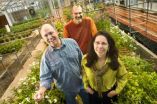ICT and automotive: New app reduces motorway pile-ups by 40 percent
Road tests in Los Angeles in August; the objective is in-car Internet
2011-07-12
(Press-News.org) According to the researchers from the University of Bologna (Italy) who designed the app, this automatic accident detection system could reduce the number of vehicles involved in pile-ups by up to 40 percent. For now, at least, that's what it does on paper and in computer simulations, as is described in an article published in the scientific journal Computer Networks. Road tests will be carried out this summer, on the streets and highways of Los Angeles, around the campus of the University of California. Here, together with engineers from Toyota, other scientists are also working on the system hardware. And it is not by chance that this project has aroused such interest in the shade of the palm trees along Sunset Boulevard. There is much more than a software app that reduces accidents at stake. The challenge in fact lies in the technology which in the near future will see millions of cars on-line.
"Basically, what we are doing is placing cars in peer to peer communication," comments Marco Roccetti, professor of Internet architecture at the University of Bologna. If an accident occurs further along the road, the car finds out about it from one of the cars ahead in a split second, and informs the driver. The cars send information to each other. And the first car to set off the alarm is the one which is impacting, or go out of control. "All it requires is an acceleration sensor," explains Gustavo Marfìa, one of the other authors of this research study. "There are anomalous movements which can only be caused by an accident."
In a realistic scenario, with hundreds or even thousands of vehicles on an eight-lane motorway, the problem lies in making the grapevine as fast as possible, and in preventing the system from being flooded. If all the cars pass on the message received, the maximum available bandwidth would be reached very quickly, blocking all communication. So the system needs to be selective. When a car sends an accident alarm message, all those within a range of between 300 and 1000 metres receive the signal, but only one of them in turn sends it on, to reach cars that are further away. But how is the car which sends on the message identified?
Until now, the most evolved systems chose the one furthest from the car that triggers the signal. Being the furthest away, this car can in turn pass on the alarm message further still, researchers must have thought. But no. The idea underlying the Bologna software is very simple. "It's quite obvious," Roccetti smiles. To make propagation as fast as possible, the car has to forward the alert message not to the furthest vehicle but to the vehicle which in turn can send the signal as far as possible.
And why is this not necessarily the furthest away? Wireless communication, particularly between moving objects, is rather unforeseeable. The furthest car could have a truck behind it which limits its transmitting capacity, or could be fitted with a less powerful communication system than the one in front of it. Our app allows cars to stay in constant contact with each other. They read each other. They know the direction and speed that all the other cars are travelling. And they also know their transmitting capacity. All this information is updated every second or so. And the frequency is optimised so that it doesn't slow the system down. When the signal is sent out, the car that is in the best condition knows that it has to forward the alarm signal. And so it does. This halves the propagation times.
"The technologies we are using are already mature and available," says Alessandro Amoroso, another of the project's authors. "It could be integrated directly into the car dashboard, or in the sat-nav. If the road tests go well, deciding whether or not to launch on the market is merely a commercial issue."
The business in question however goes far beyond the accident-prevention software. What Italian and US researchers have been working on for years is the prospect of bringing the Internet into cars at a reduced cost. While the system monitors road safety, in the car the passengers can download music, publish photos and update their Facebook page. Compared to conventional smartphone-type connections, this type of technology requires less investment. It does not need hundreds of miles of cables, posts or antennas to cover the whole of the road network. It also aims to be cheap for users. To navigate on a smartphone you need a contract with a phone company. To connect to other cars in wireless, all you need is some company on the road.
INFORMATION: END
ELSE PRESS RELEASES FROM THIS DATE:
2011-07-12
People who have a long term debilitating physical illness demonstrate mental resilience according to Understanding Society, the world's largest longitudinal household study. The first findings reveal that people diagnosed with cancer, diabetes, respiratory or cardiovascular disease report similar mental health scores to those without physical illness. The survey's findings suggest that those people who may not be able to function well physically because of an illness do not necessarily suffer problems with their mental health - for example with their concentration, confidence ...
2011-07-12
The Ohio residential correctional programs – halfway houses and community-based correctional facilities – that are most successful at reducing recidivism among offenders enjoy an impressive track record.
An offender participating in the state's most successful programs is 50 percent less likely to engage in criminal activity in the two-year period following release vs. offenders who receive no guidance or services. In contrast, the least successful of these programs actually increased the chances of criminal recidivism. The least successful programs increased recidivism ...
2011-07-12
DURHAM, N.H. – Rural workers have less access to sick leave, forcing them to choose between caring for themselves or family members, and losing pay or perhaps even their jobs when faced with an illness, according to new research from the Carsey Institute at the University of New Hampshire.
"Paid sick days are a central component of job flexibility for rural and urban workers alike. Everyone gets sick, and the lack of paid sick days can place workers in a bind, especially given that workers who lack paid sick days are also more likely to lack other paid leave options, ...
2011-07-12
EAST LANSING, Mich. — By honing in on the mysterious potato genome and its tuber – its edible portion – researchers are unveiling the secrets of the world's most-important nongrain food crop.
Robin Buell, Michigan State University plant biologist, is part of an international research team that is mapping the genome of the potato. In the current issue of Nature, the team revealed that it accomplished its goal, thus quickly closing the gap on improving the food source's elusive genome.
The potato is a member of the Solanaceae, an economically important family that includes ...
2011-07-12
The Potato Genome Sequencing Consortium (PGSC), a team of scientists from institutions worldwide, including Virginia Tech, has published its findings in the Sunday July 10 online issue of the journal Nature.
The successful sequencing of the genome of the world's third most important crop began when Richard Veilleux, who is the Julian and Margaret Gary Professor of Horticulture in the College of Agriculture and Life Sciences at Virginia Tech, wondered if the then new applications of plant tissue culture could be used to develop parent lines for hybrid potatoes. The concept ...
2011-07-12
Becoming a Workamajig expert requires a replete understanding of the platform (Client Services, Project Management, Trafficking, CRM and Finance modules) and the rollout of the solution for a minimum of three agency clientele. We are extremely pleased, states Vanessa Edwards, President and Founder of CPI. "My journey with Workamajig began nearly five years ago, when I was searching for a solution to help improve my own agency's realization rates, drive efficiency and improve profitability. Post-adoption, our AGI went from 75% to 200% of the national average... providing ...
2011-07-12
BURGESS, the superyacht leader, joins OCEANA's prestigious group of corporate donors and becomes active sponsors of the group's major events and activities. Partly founded by actor Ted Danson and recently named a 4-star charity for sound fiscal management, Oceana is the largest international advocacy group working solely to protect the world's oceans.
The initial collaboration of the two organizations resulted in this year's highly successful "Bid To Save The Earth" Green Auction when heated bidding on a four day/three night BURGESS luxury yacht charter courtesy ...
2011-07-12
Saranac Lake, N.Y. – New research from the Trudeau Institute may help to explain why anticoagulant therapies have largely failed to extend the lives of patients with sepsis. The study was led by Deyan Luo, a postdoctoral fellow in Stephen Smiley's laboratory. It shows that fibrin, a key product of the blood clotting process, is critical for host defense against Yersinia enterocolitica, a gram-negative bacterium that causes sepsis in humans and experimental mice. The new data will be published in the August 15 issue of The Journal of Immunology and is available now online ...
2011-07-12
Applying a vaccine patch to the skin with thousands of tiny micro-needles could help boost the body's immune response and prevent the spread of life-threatening infections like HIV and TB, a major Cardiff University study aims to uncover.
Professor Vincent Piguet from Cardiff University's School of Medicine, has been awarded almost a million dollars by the Bill & Melinda Gates Foundation to examine how key immune cells in the skin can be targeted to cause the immune system to produce antibodies against infection.
Recent advances in the prevention and treatment of ...
2011-07-12
A new drug has recently been discovered in Russia, and is taking the country by storm. The drug is called krokodil or crocodile, named for the gruesome effects the drug has on the users' appearance. The skin of the user literally begins to rot. At the injection site, which can be anywhere where there is a suitable vein, the users complexion becomes greenish and scaly, like a crocodile's, blood vessels rupture and the skin tissue dies. Gangrene and amputations are a common result, bone tissue, especially in the lower jaw begins to deteriorate, slowly being disintegrated ...
LAST 30 PRESS RELEASES:
[Press-News.org] ICT and automotive: New app reduces motorway pile-ups by 40 percent
Road tests in Los Angeles in August; the objective is in-car Internet


